Hydroxyapatite Bioceramics: Additive Manufacturing Advancements
VerifiedAdded on 2023/03/31
|11
|1983
|441
Report
AI Summary
This report provides an overview of additive manufacturing techniques for hydroxyapatite (HA), a calcium phosphate ceramic widely used in dentistry and orthopedics due to its bioactivity, biocompatibility, and osteoconduction. It discusses advancements in methods like selective laser sintering/melting (SLS/M) and stereolithography (SLA) for producing HA scaffolds with controlled porosity and mechanical properties. The report highlights the use of polymer matrices with HA fillers to create composite materials, enhancing osteoconductivity and mechanical strength. It also addresses challenges such as partial melting, ceramic dissociation, dimensional accuracy, and surface finish, suggesting future research directions to improve process control and material properties for enhanced biomedical applications. The study concludes that additive manufacturing offers promising methods for fabricating HA components with reduced fabrication time, lower costs, and design flexibility.
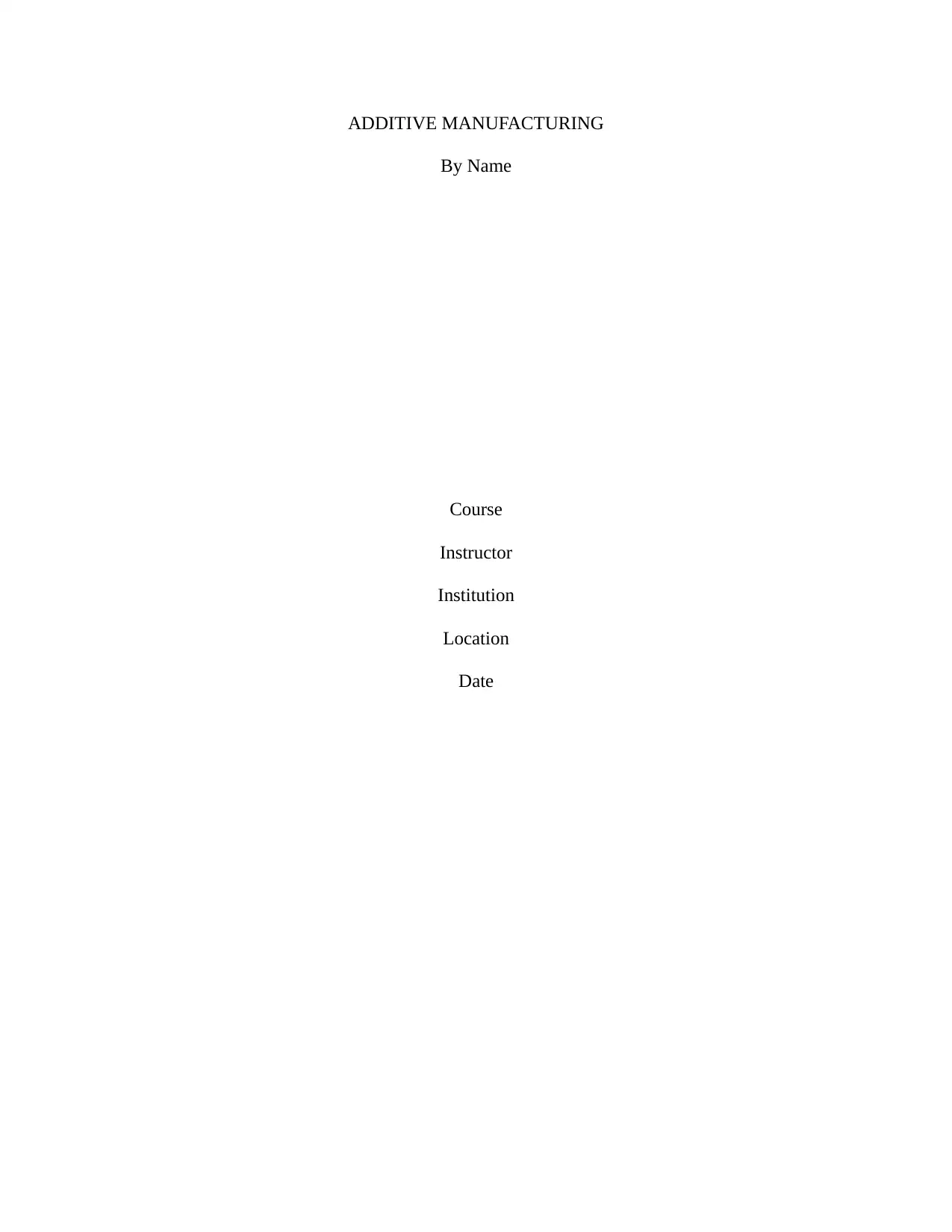
ADDITIVE MANUFACTURING
By Name
Course
Instructor
Institution
Location
Date
By Name
Course
Instructor
Institution
Location
Date
Paraphrase This Document
Need a fresh take? Get an instant paraphrase of this document with our AI Paraphraser
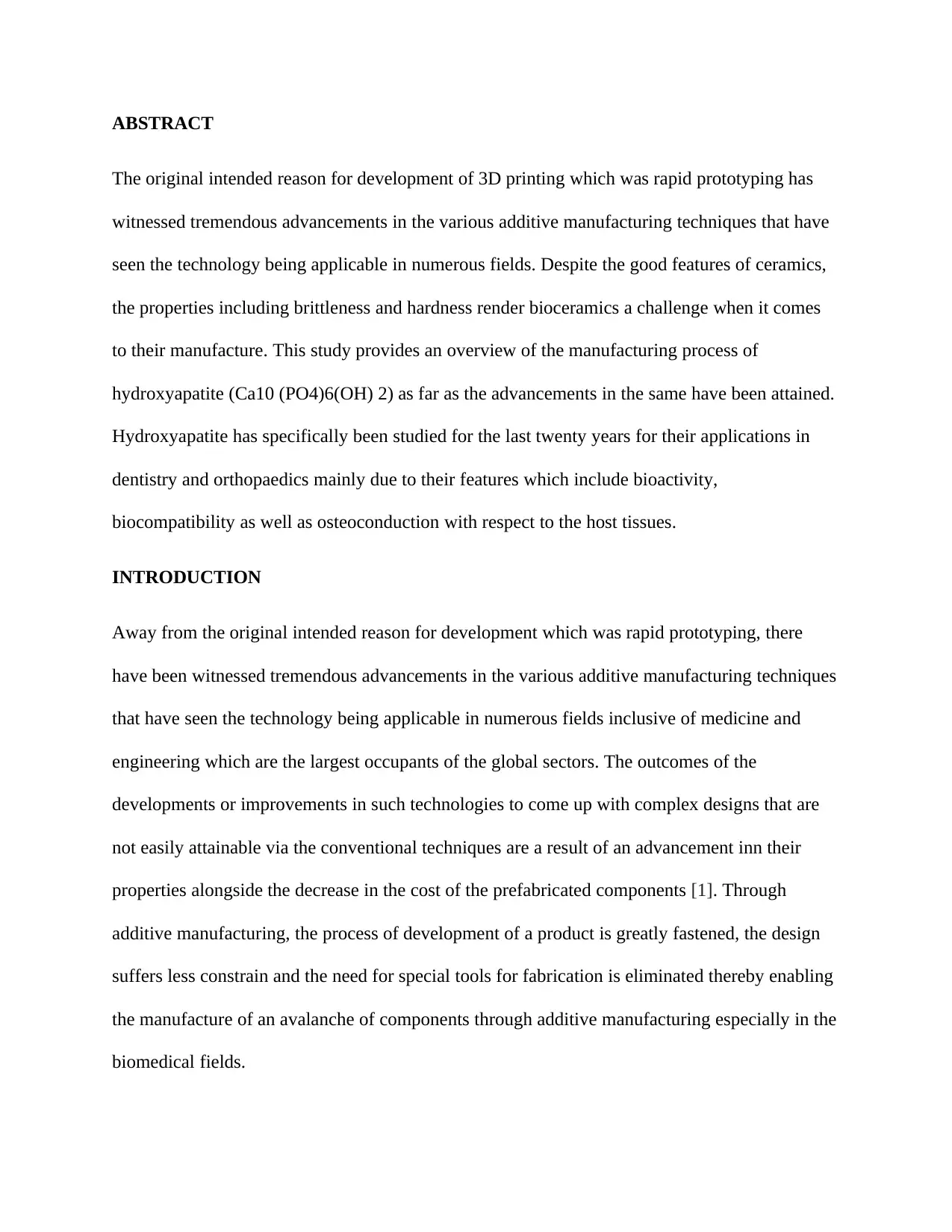
ABSTRACT
The original intended reason for development of 3D printing which was rapid prototyping has
witnessed tremendous advancements in the various additive manufacturing techniques that have
seen the technology being applicable in numerous fields. Despite the good features of ceramics,
the properties including brittleness and hardness render bioceramics a challenge when it comes
to their manufacture. This study provides an overview of the manufacturing process of
hydroxyapatite (Ca10 (PO4)6(OH) 2) as far as the advancements in the same have been attained.
Hydroxyapatite has specifically been studied for the last twenty years for their applications in
dentistry and orthopaedics mainly due to their features which include bioactivity,
biocompatibility as well as osteoconduction with respect to the host tissues.
INTRODUCTION
Away from the original intended reason for development which was rapid prototyping, there
have been witnessed tremendous advancements in the various additive manufacturing techniques
that have seen the technology being applicable in numerous fields inclusive of medicine and
engineering which are the largest occupants of the global sectors. The outcomes of the
developments or improvements in such technologies to come up with complex designs that are
not easily attainable via the conventional techniques are a result of an advancement inn their
properties alongside the decrease in the cost of the prefabricated components [1]. Through
additive manufacturing, the process of development of a product is greatly fastened, the design
suffers less constrain and the need for special tools for fabrication is eliminated thereby enabling
the manufacture of an avalanche of components through additive manufacturing especially in the
biomedical fields.
The original intended reason for development of 3D printing which was rapid prototyping has
witnessed tremendous advancements in the various additive manufacturing techniques that have
seen the technology being applicable in numerous fields. Despite the good features of ceramics,
the properties including brittleness and hardness render bioceramics a challenge when it comes
to their manufacture. This study provides an overview of the manufacturing process of
hydroxyapatite (Ca10 (PO4)6(OH) 2) as far as the advancements in the same have been attained.
Hydroxyapatite has specifically been studied for the last twenty years for their applications in
dentistry and orthopaedics mainly due to their features which include bioactivity,
biocompatibility as well as osteoconduction with respect to the host tissues.
INTRODUCTION
Away from the original intended reason for development which was rapid prototyping, there
have been witnessed tremendous advancements in the various additive manufacturing techniques
that have seen the technology being applicable in numerous fields inclusive of medicine and
engineering which are the largest occupants of the global sectors. The outcomes of the
developments or improvements in such technologies to come up with complex designs that are
not easily attainable via the conventional techniques are a result of an advancement inn their
properties alongside the decrease in the cost of the prefabricated components [1]. Through
additive manufacturing, the process of development of a product is greatly fastened, the design
suffers less constrain and the need for special tools for fabrication is eliminated thereby enabling
the manufacture of an avalanche of components through additive manufacturing especially in the
biomedical fields.
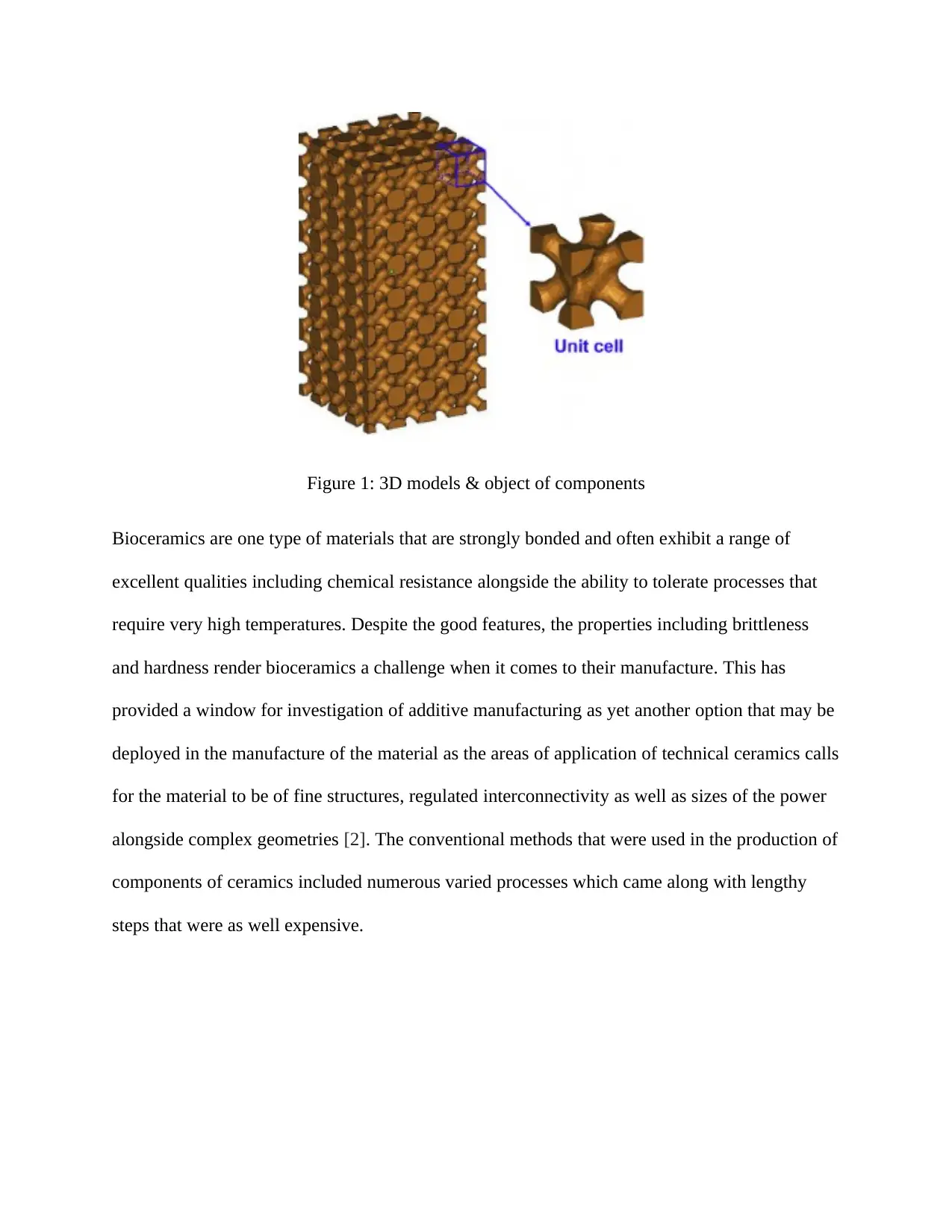
Figure 1: 3D models & object of components
Bioceramics are one type of materials that are strongly bonded and often exhibit a range of
excellent qualities including chemical resistance alongside the ability to tolerate processes that
require very high temperatures. Despite the good features, the properties including brittleness
and hardness render bioceramics a challenge when it comes to their manufacture. This has
provided a window for investigation of additive manufacturing as yet another option that may be
deployed in the manufacture of the material as the areas of application of technical ceramics calls
for the material to be of fine structures, regulated interconnectivity as well as sizes of the power
alongside complex geometries [2]. The conventional methods that were used in the production of
components of ceramics included numerous varied processes which came along with lengthy
steps that were as well expensive.
Bioceramics are one type of materials that are strongly bonded and often exhibit a range of
excellent qualities including chemical resistance alongside the ability to tolerate processes that
require very high temperatures. Despite the good features, the properties including brittleness
and hardness render bioceramics a challenge when it comes to their manufacture. This has
provided a window for investigation of additive manufacturing as yet another option that may be
deployed in the manufacture of the material as the areas of application of technical ceramics calls
for the material to be of fine structures, regulated interconnectivity as well as sizes of the power
alongside complex geometries [2]. The conventional methods that were used in the production of
components of ceramics included numerous varied processes which came along with lengthy
steps that were as well expensive.
⊘ This is a preview!⊘
Do you want full access?
Subscribe today to unlock all pages.

Trusted by 1+ million students worldwide

LITERATURE REVIEW
This study provides an overview of the manufacturing process of hydroxyapatite (Ca10
(PO4)6(OH) 2) as far as the advancements in the same have been attained to this extent and
hence the opportunities for future research on the same.
Hydroxyapatite (HA)
Ceramics of calcium phosphate and more categorically hydroxyapatite (Ca10 (PO4)6(OH) 2) are
often used as substitutes for synthetic graft, fillers as well as spacers. Hydroxyapatite has
specifically been studied for the last twenty years for their applications in dentistry and
orthopaedics mainly due to their features which include bioactivity, biocompatibility as well as
osteoconduction with respect to the host tissues [3].
Figure 2: MC3T3-E1 cells morphology for hydroxyapatite sample
3D scaffolds of poly ether ether ketone hydroxyapatite biocomposites was obtained by Tan et al.
with the use of laser sintering. Porous hydroxyapatite scaffolds were successfully prepared by
Shao et al. for use in bone tissue engineering with the use of 3D printing technology.
Hydroxyapatite bone tissues scaffolds were also fabricated by Sophie et al. using 3D printing and
This study provides an overview of the manufacturing process of hydroxyapatite (Ca10
(PO4)6(OH) 2) as far as the advancements in the same have been attained to this extent and
hence the opportunities for future research on the same.
Hydroxyapatite (HA)
Ceramics of calcium phosphate and more categorically hydroxyapatite (Ca10 (PO4)6(OH) 2) are
often used as substitutes for synthetic graft, fillers as well as spacers. Hydroxyapatite has
specifically been studied for the last twenty years for their applications in dentistry and
orthopaedics mainly due to their features which include bioactivity, biocompatibility as well as
osteoconduction with respect to the host tissues [3].
Figure 2: MC3T3-E1 cells morphology for hydroxyapatite sample
3D scaffolds of poly ether ether ketone hydroxyapatite biocomposites was obtained by Tan et al.
with the use of laser sintering. Porous hydroxyapatite scaffolds were successfully prepared by
Shao et al. for use in bone tissue engineering with the use of 3D printing technology.
Hydroxyapatite bone tissues scaffolds were also fabricated by Sophie et al. using 3D printing and
Paraphrase This Document
Need a fresh take? Get an instant paraphrase of this document with our AI Paraphraser
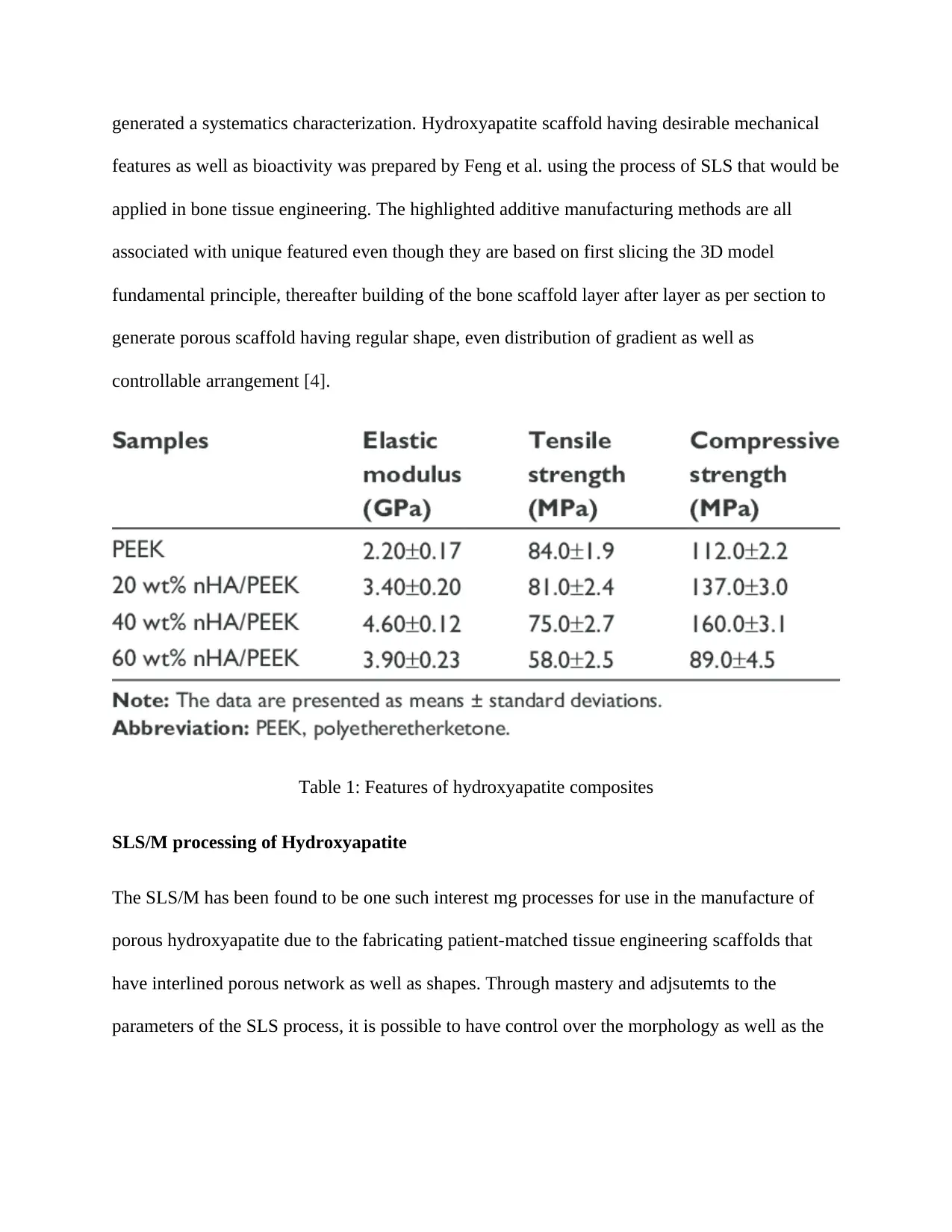
generated a systematics characterization. Hydroxyapatite scaffold having desirable mechanical
features as well as bioactivity was prepared by Feng et al. using the process of SLS that would be
applied in bone tissue engineering. The highlighted additive manufacturing methods are all
associated with unique featured even though they are based on first slicing the 3D model
fundamental principle, thereafter building of the bone scaffold layer after layer as per section to
generate porous scaffold having regular shape, even distribution of gradient as well as
controllable arrangement [4].
Table 1: Features of hydroxyapatite composites
SLS/M processing of Hydroxyapatite
The SLS/M has been found to be one such interest mg processes for use in the manufacture of
porous hydroxyapatite due to the fabricating patient-matched tissue engineering scaffolds that
have interlined porous network as well as shapes. Through mastery and adjsutemts to the
parameters of the SLS process, it is possible to have control over the morphology as well as the
features as well as bioactivity was prepared by Feng et al. using the process of SLS that would be
applied in bone tissue engineering. The highlighted additive manufacturing methods are all
associated with unique featured even though they are based on first slicing the 3D model
fundamental principle, thereafter building of the bone scaffold layer after layer as per section to
generate porous scaffold having regular shape, even distribution of gradient as well as
controllable arrangement [4].
Table 1: Features of hydroxyapatite composites
SLS/M processing of Hydroxyapatite
The SLS/M has been found to be one such interest mg processes for use in the manufacture of
porous hydroxyapatite due to the fabricating patient-matched tissue engineering scaffolds that
have interlined porous network as well as shapes. Through mastery and adjsutemts to the
parameters of the SLS process, it is possible to have control over the morphology as well as the
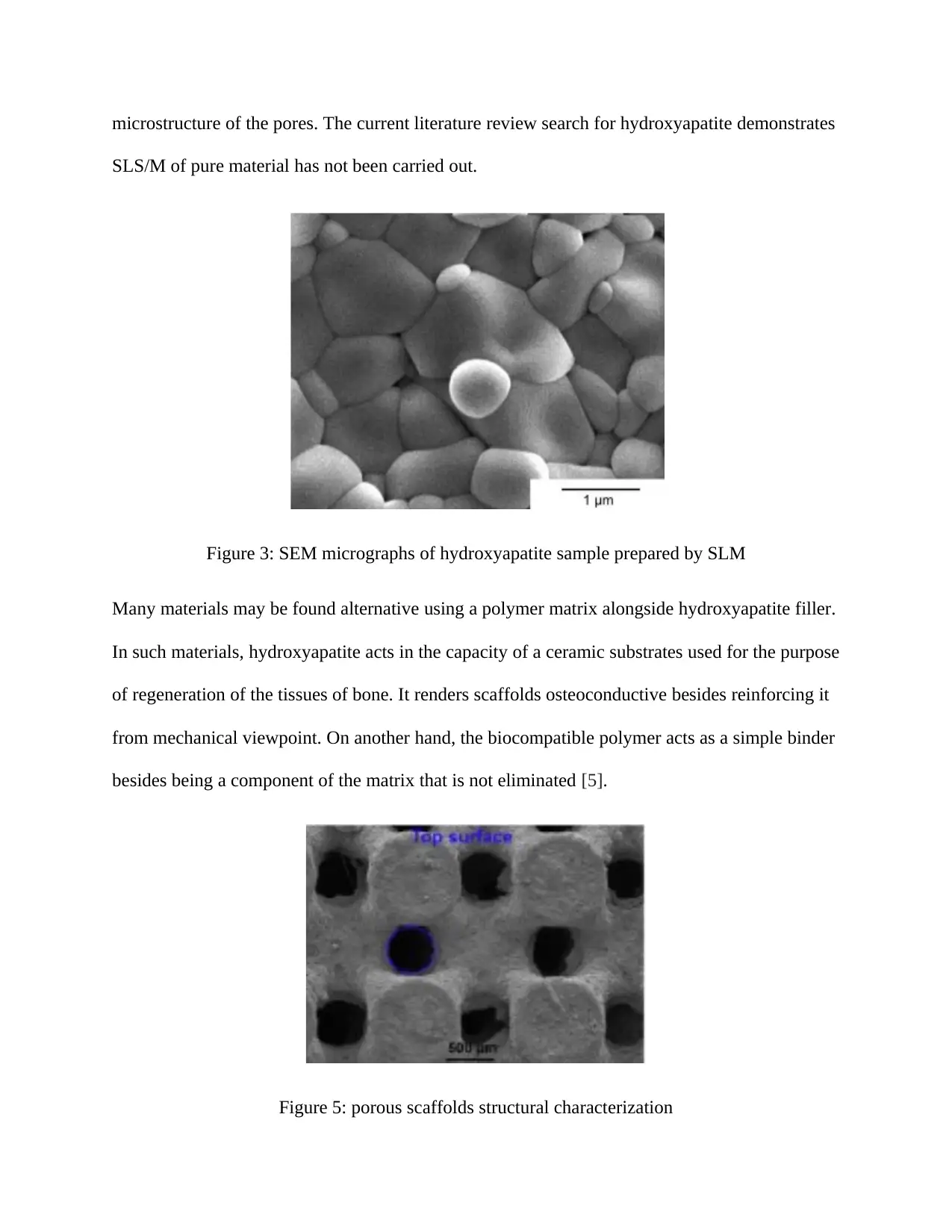
microstructure of the pores. The current literature review search for hydroxyapatite demonstrates
SLS/M of pure material has not been carried out.
Figure 3: SEM micrographs of hydroxyapatite sample prepared by SLM
Many materials may be found alternative using a polymer matrix alongside hydroxyapatite filler.
In such materials, hydroxyapatite acts in the capacity of a ceramic substrates used for the purpose
of regeneration of the tissues of bone. It renders scaffolds osteoconductive besides reinforcing it
from mechanical viewpoint. On another hand, the biocompatible polymer acts as a simple binder
besides being a component of the matrix that is not eliminated [5].
Figure 5: porous scaffolds structural characterization
SLS/M of pure material has not been carried out.
Figure 3: SEM micrographs of hydroxyapatite sample prepared by SLM
Many materials may be found alternative using a polymer matrix alongside hydroxyapatite filler.
In such materials, hydroxyapatite acts in the capacity of a ceramic substrates used for the purpose
of regeneration of the tissues of bone. It renders scaffolds osteoconductive besides reinforcing it
from mechanical viewpoint. On another hand, the biocompatible polymer acts as a simple binder
besides being a component of the matrix that is not eliminated [5].
Figure 5: porous scaffolds structural characterization
⊘ This is a preview!⊘
Do you want full access?
Subscribe today to unlock all pages.

Trusted by 1+ million students worldwide
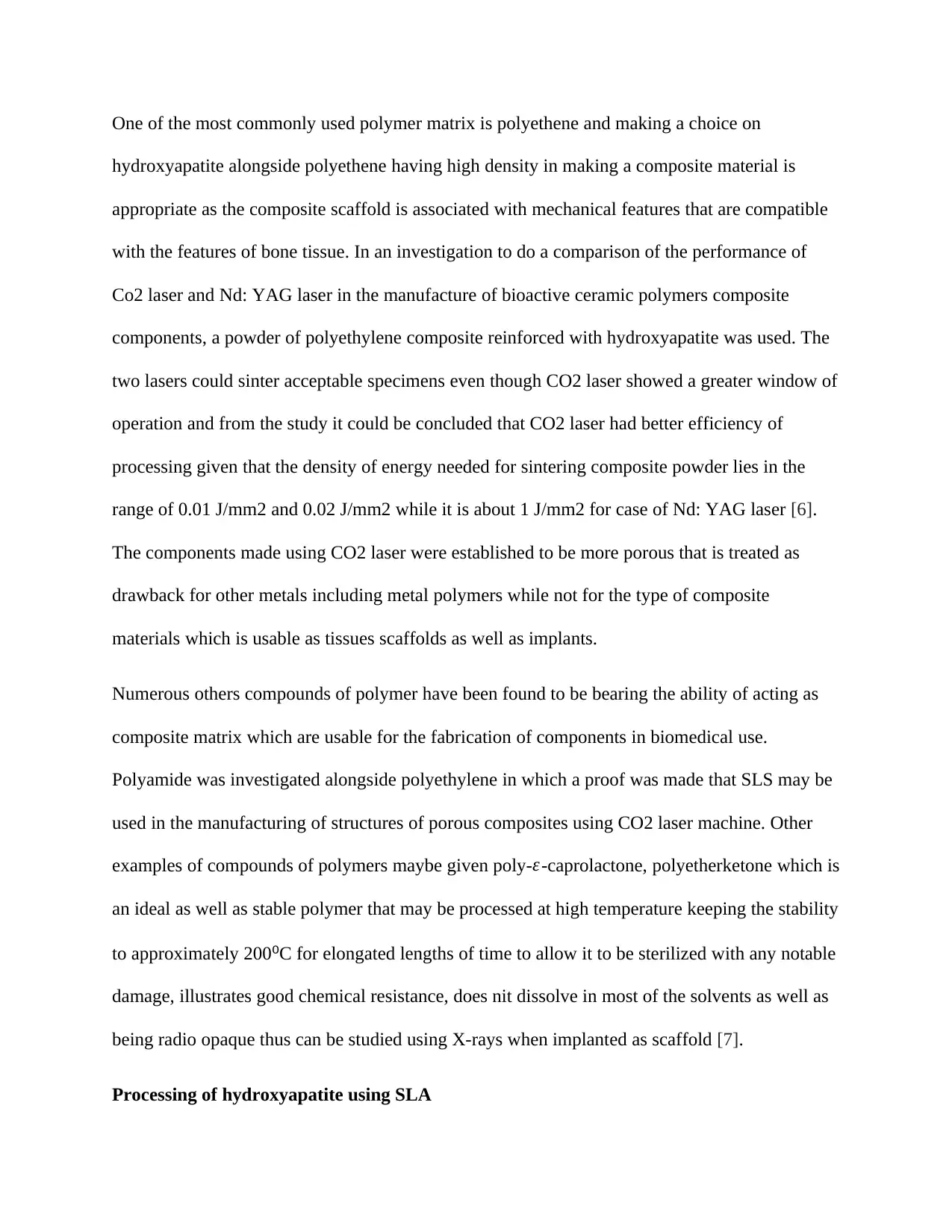
One of the most commonly used polymer matrix is polyethene and making a choice on
hydroxyapatite alongside polyethene having high density in making a composite material is
appropriate as the composite scaffold is associated with mechanical features that are compatible
with the features of bone tissue. In an investigation to do a comparison of the performance of
Co2 laser and Nd: YAG laser in the manufacture of bioactive ceramic polymers composite
components, a powder of polyethylene composite reinforced with hydroxyapatite was used. The
two lasers could sinter acceptable specimens even though CO2 laser showed a greater window of
operation and from the study it could be concluded that CO2 laser had better efficiency of
processing given that the density of energy needed for sintering composite powder lies in the
range of 0.01 J/mm2 and 0.02 J/mm2 while it is about 1 J/mm2 for case of Nd: YAG laser [6].
The components made using CO2 laser were established to be more porous that is treated as
drawback for other metals including metal polymers while not for the type of composite
materials which is usable as tissues scaffolds as well as implants.
Numerous others compounds of polymer have been found to be bearing the ability of acting as
composite matrix which are usable for the fabrication of components in biomedical use.
Polyamide was investigated alongside polyethylene in which a proof was made that SLS may be
used in the manufacturing of structures of porous composites using CO2 laser machine. Other
examples of compounds of polymers maybe given poly- ε-caprolactone, polyetherketone which is
an ideal as well as stable polymer that may be processed at high temperature keeping the stability
to approximately 200⁰C for elongated lengths of time to allow it to be sterilized with any notable
damage, illustrates good chemical resistance, does nit dissolve in most of the solvents as well as
being radio opaque thus can be studied using X-rays when implanted as scaffold [7].
Processing of hydroxyapatite using SLA
hydroxyapatite alongside polyethene having high density in making a composite material is
appropriate as the composite scaffold is associated with mechanical features that are compatible
with the features of bone tissue. In an investigation to do a comparison of the performance of
Co2 laser and Nd: YAG laser in the manufacture of bioactive ceramic polymers composite
components, a powder of polyethylene composite reinforced with hydroxyapatite was used. The
two lasers could sinter acceptable specimens even though CO2 laser showed a greater window of
operation and from the study it could be concluded that CO2 laser had better efficiency of
processing given that the density of energy needed for sintering composite powder lies in the
range of 0.01 J/mm2 and 0.02 J/mm2 while it is about 1 J/mm2 for case of Nd: YAG laser [6].
The components made using CO2 laser were established to be more porous that is treated as
drawback for other metals including metal polymers while not for the type of composite
materials which is usable as tissues scaffolds as well as implants.
Numerous others compounds of polymer have been found to be bearing the ability of acting as
composite matrix which are usable for the fabrication of components in biomedical use.
Polyamide was investigated alongside polyethylene in which a proof was made that SLS may be
used in the manufacturing of structures of porous composites using CO2 laser machine. Other
examples of compounds of polymers maybe given poly- ε-caprolactone, polyetherketone which is
an ideal as well as stable polymer that may be processed at high temperature keeping the stability
to approximately 200⁰C for elongated lengths of time to allow it to be sterilized with any notable
damage, illustrates good chemical resistance, does nit dissolve in most of the solvents as well as
being radio opaque thus can be studied using X-rays when implanted as scaffold [7].
Processing of hydroxyapatite using SLA
Paraphrase This Document
Need a fresh take? Get an instant paraphrase of this document with our AI Paraphraser
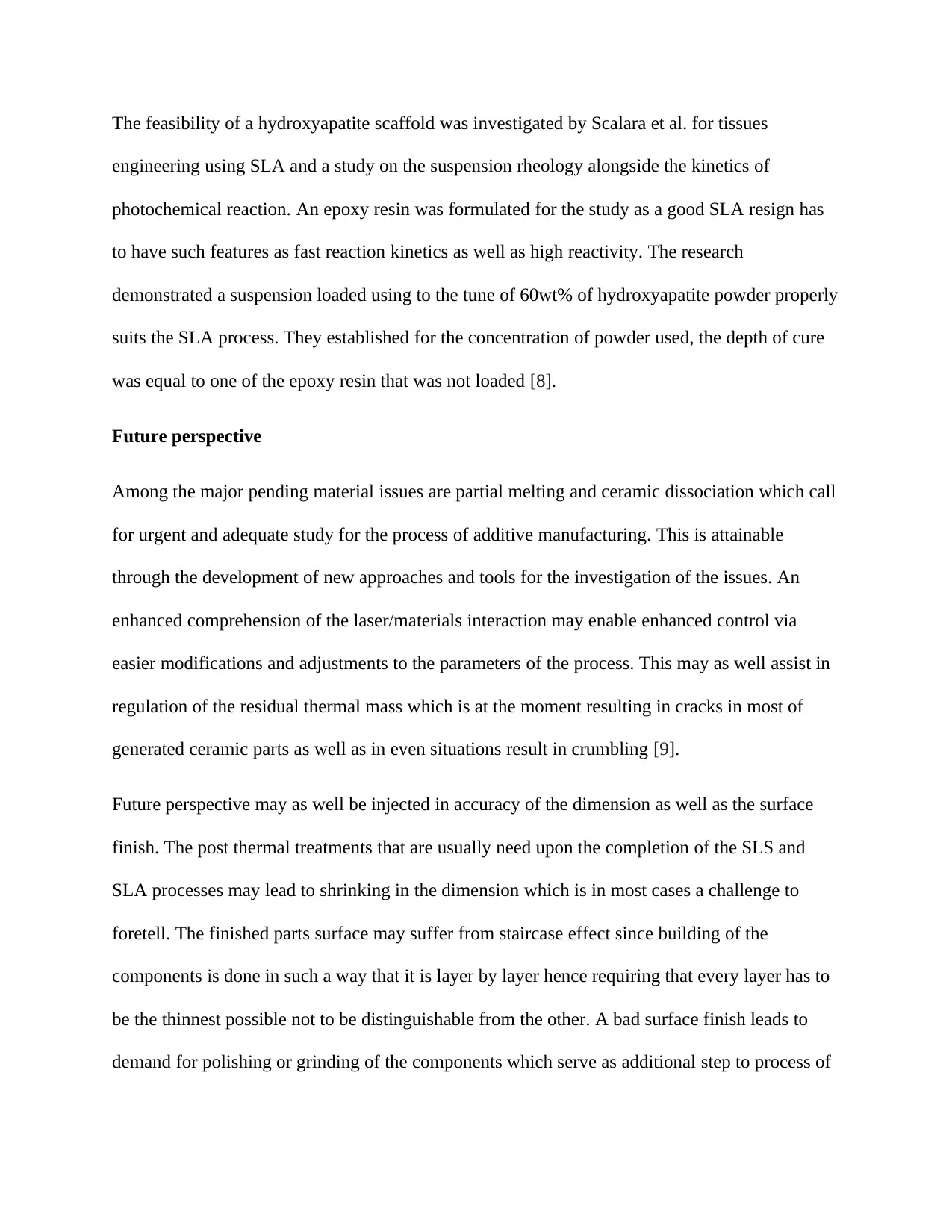
The feasibility of a hydroxyapatite scaffold was investigated by Scalara et al. for tissues
engineering using SLA and a study on the suspension rheology alongside the kinetics of
photochemical reaction. An epoxy resin was formulated for the study as a good SLA resign has
to have such features as fast reaction kinetics as well as high reactivity. The research
demonstrated a suspension loaded using to the tune of 60wt% of hydroxyapatite powder properly
suits the SLA process. They established for the concentration of powder used, the depth of cure
was equal to one of the epoxy resin that was not loaded [8].
Future perspective
Among the major pending material issues are partial melting and ceramic dissociation which call
for urgent and adequate study for the process of additive manufacturing. This is attainable
through the development of new approaches and tools for the investigation of the issues. An
enhanced comprehension of the laser/materials interaction may enable enhanced control via
easier modifications and adjustments to the parameters of the process. This may as well assist in
regulation of the residual thermal mass which is at the moment resulting in cracks in most of
generated ceramic parts as well as in even situations result in crumbling [9].
Future perspective may as well be injected in accuracy of the dimension as well as the surface
finish. The post thermal treatments that are usually need upon the completion of the SLS and
SLA processes may lead to shrinking in the dimension which is in most cases a challenge to
foretell. The finished parts surface may suffer from staircase effect since building of the
components is done in such a way that it is layer by layer hence requiring that every layer has to
be the thinnest possible not to be distinguishable from the other. A bad surface finish leads to
demand for polishing or grinding of the components which serve as additional step to process of
engineering using SLA and a study on the suspension rheology alongside the kinetics of
photochemical reaction. An epoxy resin was formulated for the study as a good SLA resign has
to have such features as fast reaction kinetics as well as high reactivity. The research
demonstrated a suspension loaded using to the tune of 60wt% of hydroxyapatite powder properly
suits the SLA process. They established for the concentration of powder used, the depth of cure
was equal to one of the epoxy resin that was not loaded [8].
Future perspective
Among the major pending material issues are partial melting and ceramic dissociation which call
for urgent and adequate study for the process of additive manufacturing. This is attainable
through the development of new approaches and tools for the investigation of the issues. An
enhanced comprehension of the laser/materials interaction may enable enhanced control via
easier modifications and adjustments to the parameters of the process. This may as well assist in
regulation of the residual thermal mass which is at the moment resulting in cracks in most of
generated ceramic parts as well as in even situations result in crumbling [9].
Future perspective may as well be injected in accuracy of the dimension as well as the surface
finish. The post thermal treatments that are usually need upon the completion of the SLS and
SLA processes may lead to shrinking in the dimension which is in most cases a challenge to
foretell. The finished parts surface may suffer from staircase effect since building of the
components is done in such a way that it is layer by layer hence requiring that every layer has to
be the thinnest possible not to be distinguishable from the other. A bad surface finish leads to
demand for polishing or grinding of the components which serve as additional step to process of

manufacturing. Stereo lithography is additive manufacturing method having best resolution and
hence provides best surface finish [10].
Conclusion
Additive manufacturing of bioceramics using various processes mostly the manufacture of
hydroxyapatite using such methods as selective sintering/meting and stereo lithography offer
some of the promising methods and components for use in biomedical applications. The
manufacturing materials also studies into the manufacture of new materials and the use of such
processes result in combination of numerous advantages including a decrease in the length of
time for fabrication as well as costs of the products alongside reduced constrained design of the
various components. Hydroxyapatite has undergone various advancements that have allowed the
use of the various admirable features in biomedical applications even though there are still
numerous issues that need to address to ensure even better results of the obtained parts.
hence provides best surface finish [10].
Conclusion
Additive manufacturing of bioceramics using various processes mostly the manufacture of
hydroxyapatite using such methods as selective sintering/meting and stereo lithography offer
some of the promising methods and components for use in biomedical applications. The
manufacturing materials also studies into the manufacture of new materials and the use of such
processes result in combination of numerous advantages including a decrease in the length of
time for fabrication as well as costs of the products alongside reduced constrained design of the
various components. Hydroxyapatite has undergone various advancements that have allowed the
use of the various admirable features in biomedical applications even though there are still
numerous issues that need to address to ensure even better results of the obtained parts.
⊘ This is a preview!⊘
Do you want full access?
Subscribe today to unlock all pages.

Trusted by 1+ million students worldwide
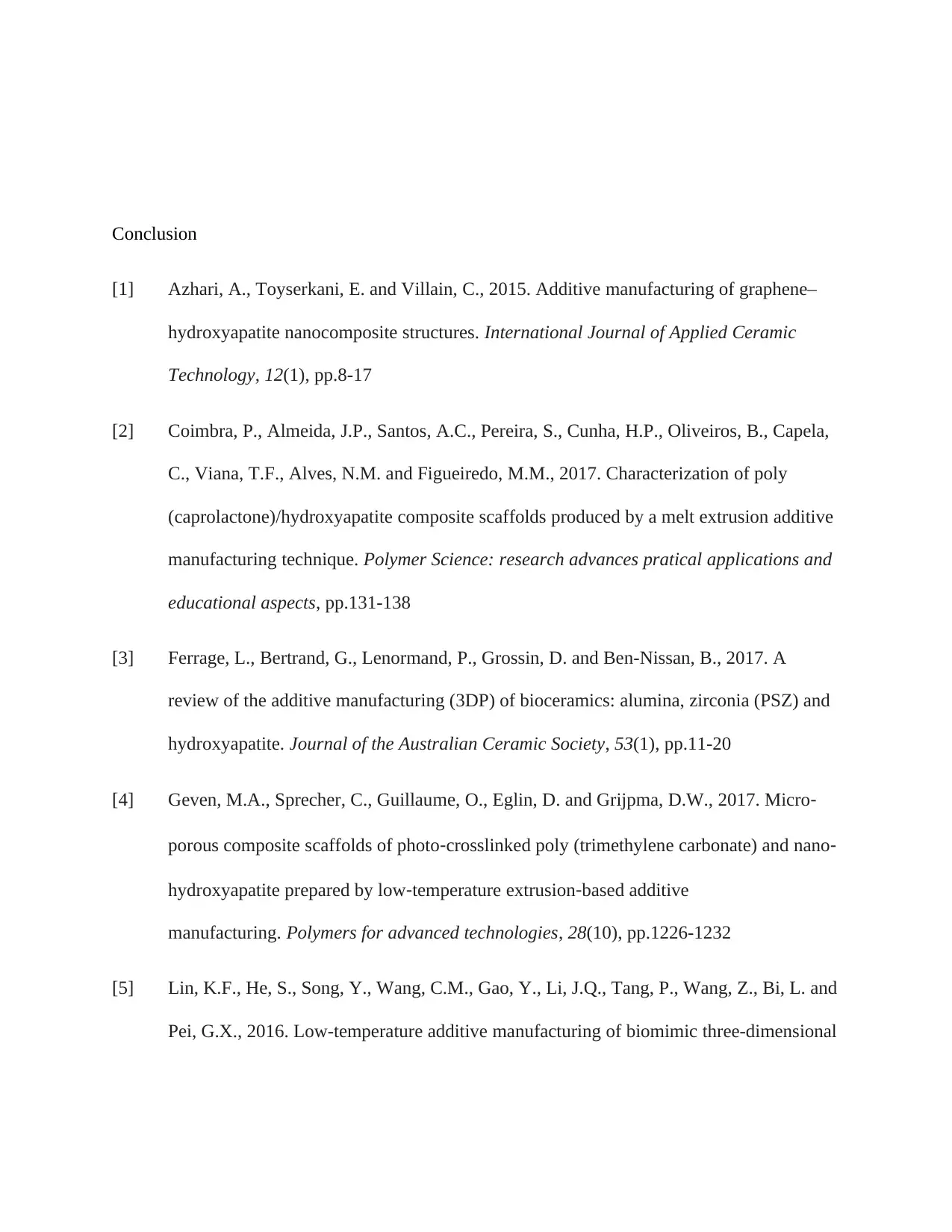
Conclusion
[1] Azhari, A., Toyserkani, E. and Villain, C., 2015. Additive manufacturing of graphene–
hydroxyapatite nanocomposite structures. International Journal of Applied Ceramic
Technology, 12(1), pp.8-17
[2] Coimbra, P., Almeida, J.P., Santos, A.C., Pereira, S., Cunha, H.P., Oliveiros, B., Capela,
C., Viana, T.F., Alves, N.M. and Figueiredo, M.M., 2017. Characterization of poly
(caprolactone)/hydroxyapatite composite scaffolds produced by a melt extrusion additive
manufacturing technique. Polymer Science: research advances pratical applications and
educational aspects, pp.131-138
[3] Ferrage, L., Bertrand, G., Lenormand, P., Grossin, D. and Ben-Nissan, B., 2017. A
review of the additive manufacturing (3DP) of bioceramics: alumina, zirconia (PSZ) and
hydroxyapatite. Journal of the Australian Ceramic Society, 53(1), pp.11-20
[4] Geven, M.A., Sprecher, C., Guillaume, O., Eglin, D. and Grijpma, D.W., 2017. Micro‐
porous composite scaffolds of photo‐crosslinked poly (trimethylene carbonate) and nano‐
hydroxyapatite prepared by low‐temperature extrusion‐based additive
manufacturing. Polymers for advanced technologies, 28(10), pp.1226-1232
[5] Lin, K.F., He, S., Song, Y., Wang, C.M., Gao, Y., Li, J.Q., Tang, P., Wang, Z., Bi, L. and
Pei, G.X., 2016. Low-temperature additive manufacturing of biomimic three-dimensional
[1] Azhari, A., Toyserkani, E. and Villain, C., 2015. Additive manufacturing of graphene–
hydroxyapatite nanocomposite structures. International Journal of Applied Ceramic
Technology, 12(1), pp.8-17
[2] Coimbra, P., Almeida, J.P., Santos, A.C., Pereira, S., Cunha, H.P., Oliveiros, B., Capela,
C., Viana, T.F., Alves, N.M. and Figueiredo, M.M., 2017. Characterization of poly
(caprolactone)/hydroxyapatite composite scaffolds produced by a melt extrusion additive
manufacturing technique. Polymer Science: research advances pratical applications and
educational aspects, pp.131-138
[3] Ferrage, L., Bertrand, G., Lenormand, P., Grossin, D. and Ben-Nissan, B., 2017. A
review of the additive manufacturing (3DP) of bioceramics: alumina, zirconia (PSZ) and
hydroxyapatite. Journal of the Australian Ceramic Society, 53(1), pp.11-20
[4] Geven, M.A., Sprecher, C., Guillaume, O., Eglin, D. and Grijpma, D.W., 2017. Micro‐
porous composite scaffolds of photo‐crosslinked poly (trimethylene carbonate) and nano‐
hydroxyapatite prepared by low‐temperature extrusion‐based additive
manufacturing. Polymers for advanced technologies, 28(10), pp.1226-1232
[5] Lin, K.F., He, S., Song, Y., Wang, C.M., Gao, Y., Li, J.Q., Tang, P., Wang, Z., Bi, L. and
Pei, G.X., 2016. Low-temperature additive manufacturing of biomimic three-dimensional
Paraphrase This Document
Need a fresh take? Get an instant paraphrase of this document with our AI Paraphraser
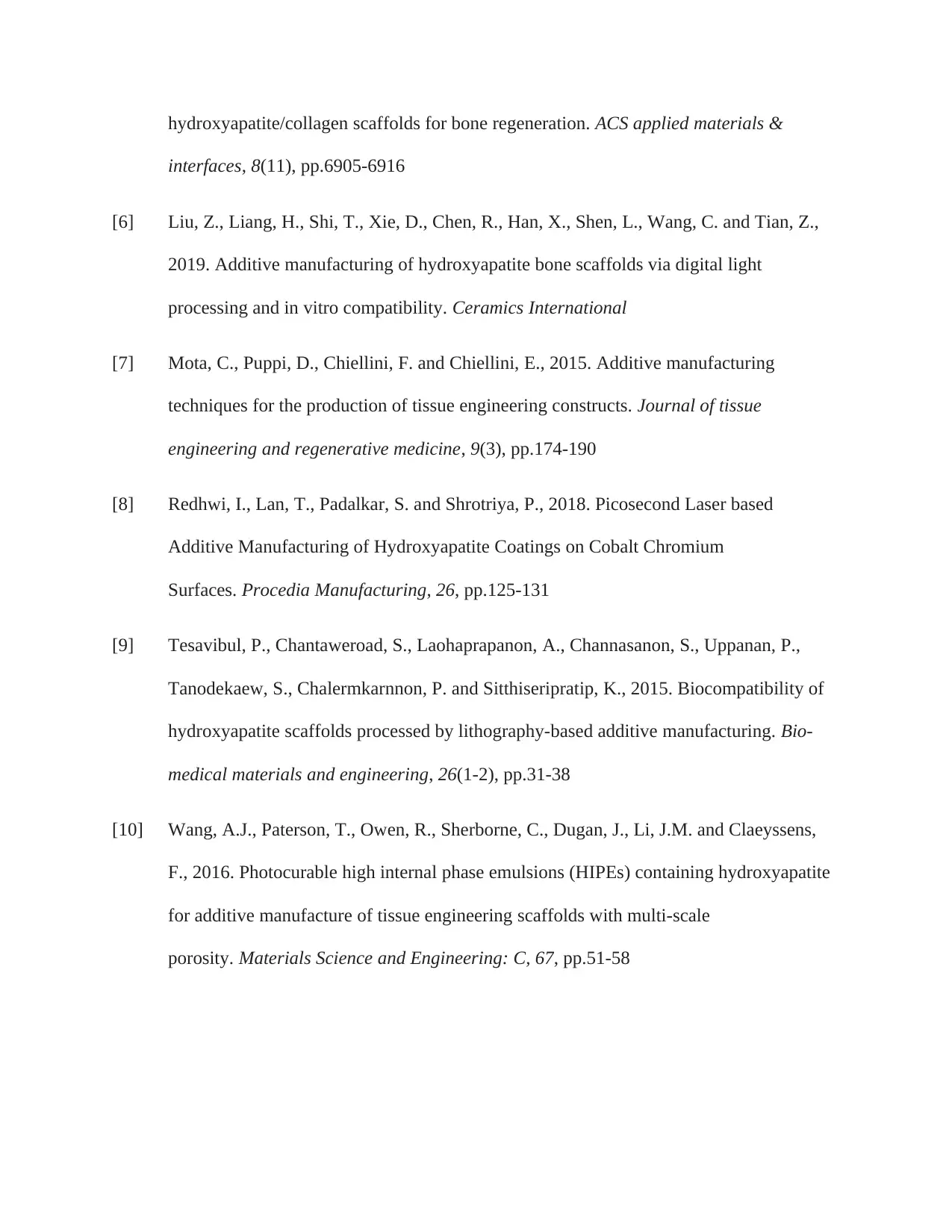
hydroxyapatite/collagen scaffolds for bone regeneration. ACS applied materials &
interfaces, 8(11), pp.6905-6916
[6] Liu, Z., Liang, H., Shi, T., Xie, D., Chen, R., Han, X., Shen, L., Wang, C. and Tian, Z.,
2019. Additive manufacturing of hydroxyapatite bone scaffolds via digital light
processing and in vitro compatibility. Ceramics International
[7] Mota, C., Puppi, D., Chiellini, F. and Chiellini, E., 2015. Additive manufacturing
techniques for the production of tissue engineering constructs. Journal of tissue
engineering and regenerative medicine, 9(3), pp.174-190
[8] Redhwi, I., Lan, T., Padalkar, S. and Shrotriya, P., 2018. Picosecond Laser based
Additive Manufacturing of Hydroxyapatite Coatings on Cobalt Chromium
Surfaces. Procedia Manufacturing, 26, pp.125-131
[9] Tesavibul, P., Chantaweroad, S., Laohaprapanon, A., Channasanon, S., Uppanan, P.,
Tanodekaew, S., Chalermkarnnon, P. and Sitthiseripratip, K., 2015. Biocompatibility of
hydroxyapatite scaffolds processed by lithography-based additive manufacturing. Bio-
medical materials and engineering, 26(1-2), pp.31-38
[10] Wang, A.J., Paterson, T., Owen, R., Sherborne, C., Dugan, J., Li, J.M. and Claeyssens,
F., 2016. Photocurable high internal phase emulsions (HIPEs) containing hydroxyapatite
for additive manufacture of tissue engineering scaffolds with multi-scale
porosity. Materials Science and Engineering: C, 67, pp.51-58
interfaces, 8(11), pp.6905-6916
[6] Liu, Z., Liang, H., Shi, T., Xie, D., Chen, R., Han, X., Shen, L., Wang, C. and Tian, Z.,
2019. Additive manufacturing of hydroxyapatite bone scaffolds via digital light
processing and in vitro compatibility. Ceramics International
[7] Mota, C., Puppi, D., Chiellini, F. and Chiellini, E., 2015. Additive manufacturing
techniques for the production of tissue engineering constructs. Journal of tissue
engineering and regenerative medicine, 9(3), pp.174-190
[8] Redhwi, I., Lan, T., Padalkar, S. and Shrotriya, P., 2018. Picosecond Laser based
Additive Manufacturing of Hydroxyapatite Coatings on Cobalt Chromium
Surfaces. Procedia Manufacturing, 26, pp.125-131
[9] Tesavibul, P., Chantaweroad, S., Laohaprapanon, A., Channasanon, S., Uppanan, P.,
Tanodekaew, S., Chalermkarnnon, P. and Sitthiseripratip, K., 2015. Biocompatibility of
hydroxyapatite scaffolds processed by lithography-based additive manufacturing. Bio-
medical materials and engineering, 26(1-2), pp.31-38
[10] Wang, A.J., Paterson, T., Owen, R., Sherborne, C., Dugan, J., Li, J.M. and Claeyssens,
F., 2016. Photocurable high internal phase emulsions (HIPEs) containing hydroxyapatite
for additive manufacture of tissue engineering scaffolds with multi-scale
porosity. Materials Science and Engineering: C, 67, pp.51-58
1 out of 11
Your All-in-One AI-Powered Toolkit for Academic Success.
+13062052269
info@desklib.com
Available 24*7 on WhatsApp / Email
![[object Object]](/_next/static/media/star-bottom.7253800d.svg)
Unlock your academic potential
© 2024 | Zucol Services PVT LTD | All rights reserved.


